Death, far from being a brutal end, is seen in many cultures as a transition, a return, or even a liberation. Understanding mourning rituals is also a way of understanding how each society embraces life with levity, gravity, spirituality, or joy. Here’s a comparative exploration of ten major cultures in how they experience mourning and living.

1. Christian West (Europe, North America)
- Mourning practices: Private and solemn ceremonies, often religious in nature.
In Western societies, mourning is often experienced privately, with ceremonies marked by sobriety. Death is typically viewed as a rupture, and religious rituals offer consolation.
- Treatment of the deceased: Burial is most common, though cremation is increasingly accepted. Bodies are typically placed in coffins and interred in cemeteries.
- Disposition of remains: Graves are often marked with tombstones; cremated ashes may be kept in urns, scattered, or buried.
- Atmosphere: Sadness, reflection, and remembrance.
- Approach to life: Death is often disconnected from daily life, reflecting a struggle to live in the present and to accept what cannot be controlled.
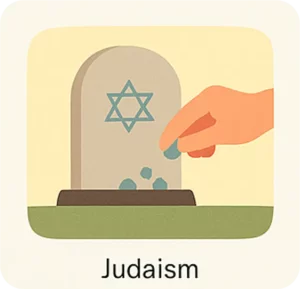
2. Judaism
- Mourning practices: Structured periods such as shiv’ah and shloshim, with community support and ritual observance.
In Jewish tradition, the community surrounds the grieving family. Mourning is structured, ritualized, and allows healthy expression of grief.
- Treatment of the deceased: Burial is mandatory. The body is washed, dressed in a simple shroud, and buried without embalming or delay.
- Disposition of remains: The grave is the final resting place. Cremation is traditionally forbidden.
- Atmosphere: Warm, with a strong community presence.
- Approach to life: Every moment has meaning. Life is a mission, and death is a spiritual continuation.

3. Islam
- Mourning practices: Quick burial within 24 hours, followed by communal prayers and remembrance.
Muslim funeral rites are performed with dignity and simplicity, rooted in deep faith.
- Treatment of the deceased: The body is washed and wrapped in a white shroud. Burial happens as soon as possible, usually within 24 hours.
- Disposition of remains: The deceased is buried directly in the earth, without a coffin if possible, facing Mecca. Cremation is prohibited.
- Atmosphere: Respectful, prayerful, and supportive.
- Approach to life: Life is a journey. Accepting death allows one to live humbly and wisely.

4. Hinduism (India)
- Mourning practices: Daily rituals, family gatherings, and prayers for the soul’s release over a 13-day or longer period.
In Hinduism, death continues the cycle of the soul. It is prepared for and accompanied to enable spiritual liberation.
- Treatment of the deceased: Cremation is standard. The body is bathed, adorned with flowers and offerings, and cremated on a pyre.
- Disposition of remains: Ashes are scattered in a sacred river, especially the Ganges, to purify the soul.
- Atmosphere: Reflective and spiritual.
- Approach to life: Detachment and self-realization. Accepting death means transcending material illusions.

5. Tibetan Buddhism
- Mourning practices: Recitations from the Book of the Dead and meditative ceremonies for up to 49 days.
In this tradition, death is a sacred moment where the soul begins a spiritual journey, guided by ritual and scripture.
- Treatment of the deceased: Sky burial is traditional. The body is respectfully dismembered and offered to vultures on mountain tops.
- Disposition of remains: Nothing is kept. The body returns to nature as an act of compassion and impermanence.
- Atmosphere: Mystical and contemplative.
- Approach to life: Impermanence lies at the heart of wisdom. Death and life are both experiences of consciousness.

6. Traditional China
- Mourning practices: Extended mourning periods with offerings, incense burning, and family gatherings.
Ancestral respect is central, and death is seen as a continuation of familial duty.
- Treatment of the deceased: Burial is traditional, with elaborate rituals and offerings. In some areas, cremation is also practiced.
- Disposition of remains: Graves are maintained and visited regularly; ashes may be stored in family tombs or columbaria.
- Atmosphere: Reserved but sincere.
- Approach to life: Order and harmony are paramount. Life is part of an ancestral equilibrium.
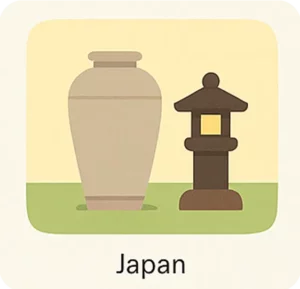
7. Japan (Buddhism and Shinto)
- Mourning practices: Memorial services held on the 7th, 49th, and 100th day, with family remembrance rituals.
Japanese funeral rites blend spiritual depth and aesthetic beauty.
- Treatment of the deceased: Cremation is the norm. The body is respectfully prepared, and bones are collected with chopsticks after cremation.
- Disposition of remains: Ashes are placed in urns and stored in family graves or columbaria. Annual visits and offerings are common.
- Atmosphere: Silent, dignified, respectful.
- Approach to life: The present moment is sacred. The beauty of impermanence is a central philosophy.
8. Mexico
- Mourning practices: Ongoing through annual Day of the Dead celebrations, honoring deceased loved ones joyfully.
The Day of the Dead is a vibrant celebration filled with love and joyful remembrance.
- Treatment of the deceased: Burial is traditional, though cremation is growing in popularity.
- Disposition of remains: Graves are decorated yearly with candles, flowers, and favorite foods. Ashes, if present, are sometimes part of altars.
- Atmosphere: Festive, joyful, family-oriented.
- Approach to life: Live fully, love deeply. Death is part of life.
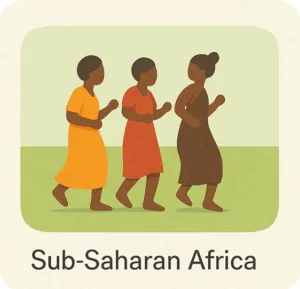
9. Sub-Saharan Africa
- Mourning practices: Extended community rituals with music, dance, and storytelling.
Death connects the visible and invisible. Funerals are communal, vibrant, and deeply symbolic.
- Treatment of the deceased: Burial is most common. Ceremonies include traditional music, dances, and ritual offerings.
- Disposition of remains: Graves may become family shrines. The spirit of the deceased is honored through ancestral worship.
- Atmosphere: Both solemn and celebratory.
- Approach to life: Life continues beyond death. The deceased remains present within the community.
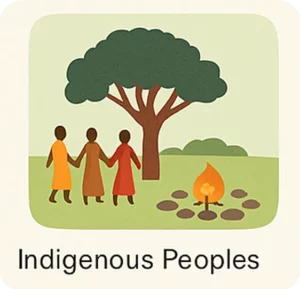
10. Indigenous Peoples (Native American, Aboriginal)
- Mourning practices: Varying ceremonies depending on tribe, including chants, offerings, and nature-based rites.
Indigenous funeral rites honor the natural cycle of life and the sacred bond with the Earth.
- Treatment of the deceased: Practices vary widely. Some involve burial, others sky or tree burials, or cremation.
- Disposition of remains: Bodies or ashes are returned to nature, often with symbolic offerings.
- Atmosphere: Deeply spiritual and communal.
- Approach to life: Living in harmony with nature’s cycles. Death is a return to the Great Whole.
Conclusion: Accepting Death to Embrace Life
Across the world, cultures teach us that death is not the opposite of life, but its mirror. The more we deny it, the more we fear living. By embracing death, we learn to live with intensity, gratitude, and presence. Releasing the soul of the departed allows it to reach the beyond—and frees the living from fear.
To accept death is, ultimately, to honor life.


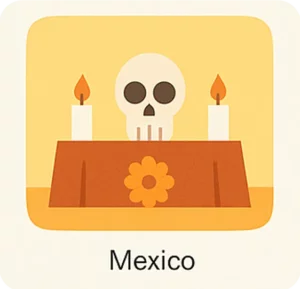
0 Comments